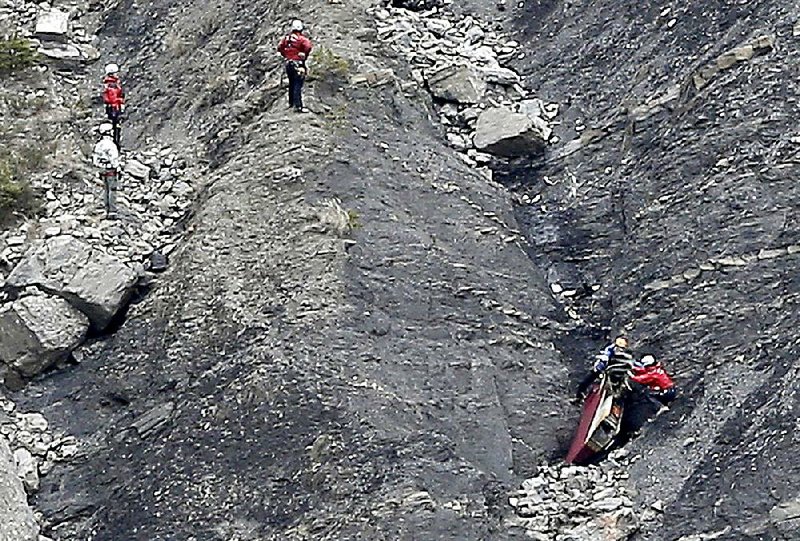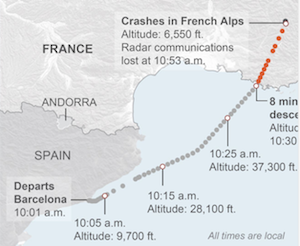Correction: Seyne-les-Alpes is the French village that became a gathering place for victims’ relatives and others connected to the crash of a Germanwings jet that went down in the French Alps in March. This article that used New York Times reporting misspelled the village’s name.
SEYNE-LES-ALPES, France -- French investigators cracked open a mangled black box and extracted audio from its cockpit voice recorder Wednesday but said they gleaned no explanation for why a German plane dropped unexpectedly and smashed into a mountain, killing all 150 on board.
The cockpit voice recorder is considered key to knowing why the pilots of Germanwings Flight 9525 lost radio contact with air traffic controllers over the French Alps and then crashed Tuesday during a routine flight from Barcelona, Spain, to Duesseldorf, Germany.
French officials said terrorism appeared unlikely, and Germany's top security official said Wednesday that there was no evidence of foul play.
Remi Jouty, director of the French aviation investigative agency, said an audio file was recovered by Wednesday afternoon, including sounds and voices. But he said it was too early to draw any conclusions from the recorder, which takes audio feeds from four microphones in the cockpit and records all the conversations between the pilots and air traffic controllers, as well as any noises.
Jouty said the plane was flying "until the end" and was at 6,000 feet just before it smashed into the mountainside, well below its previous cruising altitude of 38,000 feet. He said the final communication from the plane was a routine message about permission to continue on its route.
He would not speculate on possible causes of the crash or rule anything out.
Lufthansa Chief Executive Officer Carsten Spohr, himself a pilot, said Wednesday that "we still cannot understand what happened yesterday." He said his airline, of which Germanwings is a budget subsidiary, "never in its history has lost an aircraft in cruise flight."
French President Francois Hollande, meanwhile, said the case for the plane's second black box had been found but not its contents. Jouty did not confirm that. The flight-data recorder captures 25 hours' worth of information on the position and condition of almost every major part in a plane.
Hollande promised that French investigators would do everything to determine the crash's cause.
"At this moment people are on the scene still searching," Hollande said, speaking alongside German Chancellor Angela Merkel and Spanish Prime Minister Mariano Rajoy in Seynes-les-Alpes, the town nearest to the crash site.
All 144 passengers and six crew members aboard were presumed killed. Most of the victims were German and Spanish.
Germanwings CEO Thomas Winkelmann said the company had already contacted most families of the victims and was trying to reach the rest.
He said those aboard included 72 Germans, 35 Spaniards, three Americans and two people each from Australia, Argentina, Iran and Venezuela and one person each from Britain, the Netherlands, Colombia, Mexico, Japan, Denmark, Belgium and Israel.
Spain's government said 51 citizens had died in the crash.
The U.S. State Department said Wednesday that the Americans included government contractor Yvonne Selke of Nokesville, Va., and her daughter. The U.S. government confirmed a third American was on the plane, but that person was not identified.
The plane was less than an hour from landing in Duesseldorf when it unexpectedly went into an eight-minute descent officials said. The pilots sent out no distress call, France's aviation authority said.
Investigators will use the cockpit voice and flight-data recorders to map out and focus their work, said Alan Diehl, a former air safety investigator with the National Transportation Safety Board.
Segolene Royal, a top French government minister, said Wednesday that investigators were focusing on two key minutes of the audio recordings Tuesday -- 10:30-10:31 a.m. -- said. From then until the crash just before 11 a.m., air traffic controllers couldn't make contact with the plane, Royal said.
The New York Times on Wednesday evening quoted a senior military official involved in the investigation as saying that on the recordings, one of the pilots is heard leaving the cockpit, then banging on the door in an unsuccessful attempt to get back in.
The investigator, whom the newspaper said could not be identified because the investigation is continuing, said officials don't know why the pilot left or why the other pilot didn't open the door or make contact with ground control before the crash.
Asked about the investigator's statements, Martine del Bono, a spokesman for France's Bureau of Investigations and Analyses, declined to comment.
"Our teams continue to work on analyzing the CVR," she said, referring to the cockpit voice recorder. "As soon as we have accurate information, we intend to hold a press conference."
Information for this article was contributed by Greg Keller, Lori Hinnant, Sylvie Corbet, Angela Charlton, Kristen Grieshaber, David Rising, Geir Moulson, Alan Clendenning, Jorge Sainz, Elaine Ganley, Ted Bridis and Scott Mayerowitz of The Associated Press and by Nicola Clark and Dan Bilefsky of The New York Times.
A Section on 03/26/2015

